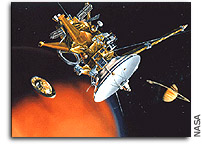Cassini Significant Events for 10/03/02 – 10/09/02
 The most recent spacecraft telemetry was acquired from the Goldstone
The most recent spacecraft telemetry was acquired from the Goldstone
tracking station on Wednesday, October 9. The Cassini spacecraft is in
an excellent state of health and is operating normally. Information on
the present position and speed of the Cassini spacecraft may be found on
the “Present Position” web page located at
http://saturn.jpl.nasa.gov/cassini/english/where/ .
This week the Composite InfraRed Spectrometer (CIRS) completed a three
day activity to test the amount of heating caused by various amounts of
sunlight on the CIRS radiator.
A Beta Gru observation was performed with the Visual and Infrared
Mapping Spectrometer (VIMS) instrument prime, with CIRS and the Imaging
Science Subsystem (ISS) riding along. The star Beta Gru is one of the
stars that VIMS will lock on and track for ring particle occultation
studies. Spectral characteristics and signal level will be recorded at
several integration times in order to correctly set the real occultation
observation instrument parameters. In addition, ISS and Ultraviolet
Imaging Spectrograph instrument teams performed an observation of the
White Dwarf HZ43.
VIMS also performed a Geometric Calibration with ISS riding along. The
full 64 X 64 pixel VIMS field of view was used for the Geometric
Calibration studies of the Pleiades star cluster. The acquired images
are used to correct for optical distortion in the instrument, and to
construct an algorithm to be applied to the images to geometrically
correct the VIMS field of view. Quick look processing of the data from
these observations has been completed. A preliminary analysis of the
ISS images showed the haze anomaly has not returned.
Additional instrument activities included a RADAR Radiometric
Calibration, Radio and Plasma Wave Science (RPWS) High Frequency
Receiver Calibration and high rate cyclic, uplink of an RPWS flight
software patch, and uplink of a Cassini Plasma Spectrometer Actuator
command file.
Science Planning reported that the Science Planning Team (SPT)
development process for C36 would be cancelled since this sequence is
exclusively in support of the CDS/ACS flight software checkout period.
During this time there are no planned science activities. The next SPT
cruise development process is scheduled to start in December for C37.
The tour Science Operations Plan (SOP) implementation of sequences
S13/S14 began this week. The process to be used has a shorter
development schedule compared to S09/S10 and S11/S12. The development
schedule is 60 workdays instead of the 72 workdays used for the previous
development activities.
The Spacecraft Operations office held their Monthly Management Review
for flight software and critical sequence development.
The Cassini Archive Coordinator and two Planetary Data System (PDS) node
representatives visited the Southwest Research Institute in Boulder,
Colorado to meet with the ISS Team Leader and staff. Discussions
covered archiving and E-kernel requirements. The meetings were very
successful. The ISS Team Leader now has an excellent understanding of
the development needed to provide E-kernel inputs, and to produce a PDS
archive.
Uplink Operations (ULO) distributed a proposal for how prime-rider
instrument coordination might be facilitated in the Cassini Information
Management System (CIMS). The proposal will be reviewed with the
distributed science teams and other CIMS users at the CIMS Working Group
meeting next week.
ULO also presented a proposal for Mission Sequence Subsystem (MSS) D9.0
and D9.0.1 delivery content at both the System Engineering Round Table
and the Instrument Operations Working Group. D9.0.1 will include
Science Opportunity Analyzer tool, items on the Pointing Design Tool
requirements list, the suspend SID flight rule Engineering Change
Request, targeting rocks, enhancements to ODD, and other miscellaneous
fixes. Everything else currently scheduled for D9.0 will remain in
D9.0, including the implementation of the new CIRS and VIMS flight rules
in PDT. The proposal was accepted and is the new MSS baseline.
Coding and acceptance testing has been completed for MSS D8.0.4. The
software has now moved on to system test. The Delivery Coordination
Meeting is scheduled for the end of October.
Delivery coordination meetings (DCM) were held for Command Database V9a,
and Cassini Operational Reference Encyclopedia (CORE) V3.0. The Command
Database V9a is specifically to be used in the Integrated Test
Laboratory for Probe relay critical sequence testing. V9b is to be
delivered later this year for use with MSS D9.0. CORE V3.0 is the
replacement of REALITY, a web-based tool to provide access to the
command and telemetry dictionaries as well as the Flight Rule
information.
RPWS delivered their flight software version 2.6 to the Project Software
Library. A Software Requirements Certification Review and DCM will be
held later in the month.
A draft schedule and list of attendees for 18 Cassini specific training
classes was released this week. Classes are scheduled to coincide with
the Project Science Group meetings later this month.
Mission Assurance participated in a joint JPL/Aerospace Corporation Risk
Management Workshop. These are an on-going series of monthly workshops,
being conducted to advance the practice of Risk Management. Discussion
during this workshop centered on developing a storyboard for risk
management and looking for common threads among implementers.
Cassini Outreach hosted an online training for 43 members of the Solar
System Ambassador Program. The training focused on the Saturn Tour.
Cassini is a cooperative project of NASA, the European Space Agency and
the Italian Space Agency. The Jet Propulsion Laboratory, a division of
the California Institute of Technology in Pasadena, Calif., manages the
Cassini mission for NASA’s Office of Space Science, Washington, D.C.








